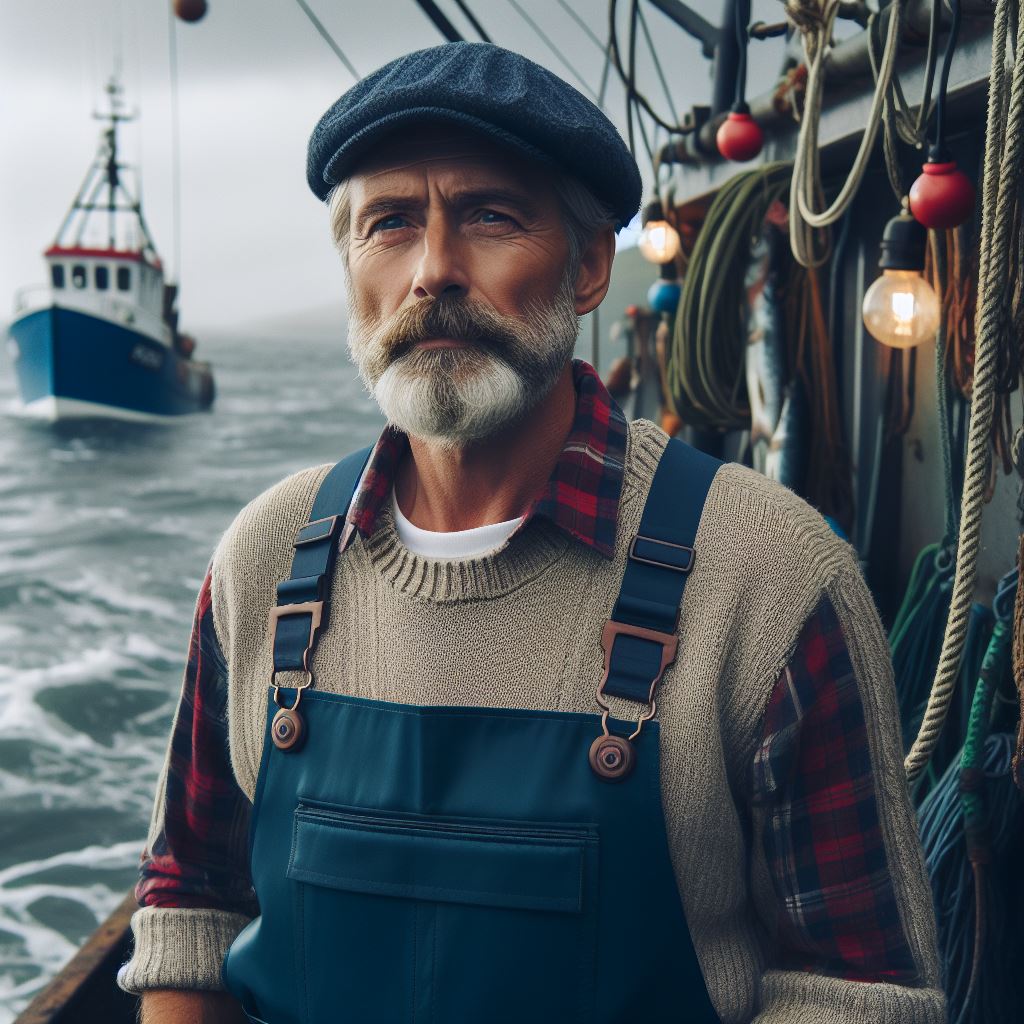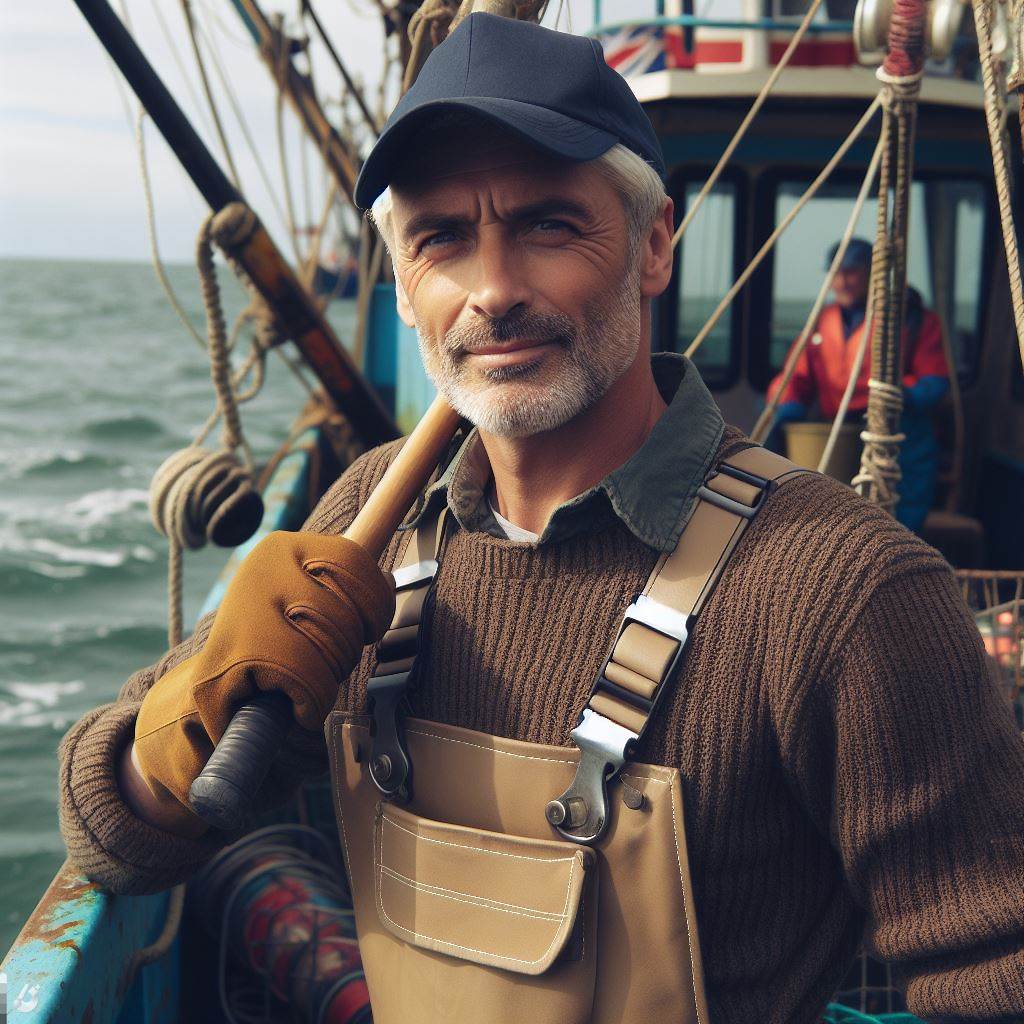Introduction
The traditional methods used by UK fishermen
- UK fishermen have long relied on traditional methods such as handlines, longlines, and gillnets.
- Handlines involve using a single fishing line with hooks, allowing for precise targeting of specific fish species.
- Longlines are set with multiple hooks and can be hundreds of meters long, catching a wide variety of fish.
- Gillnets are made of fine mesh and are placed vertically in the water, ensnaring fish by their gills.
Limitations and challenges associated with traditional fishing methods
- Traditional fishing methods often require a significant amount of physical effort and manual labour.
- These methods have limited efficiency and may result in lower catch volumes compared to more modern techniques.
- Traditional methods also pose challenges in terms of bycatch, the unintentional capture of non-targeted species.
- Bycatch can lead to ecological damage and threaten the sustainability of fish populations.
Need for technological advancements in the fishing industry
- Technological advancements in the fishing industry can address the limitations of traditional methods.
- Advanced sonar systems can assist in locating fish, saving time and effort for fishermen.
- Satellite technology can aid in tracking the movement of fish and predicting their behavior.
- Specialized fishing gear, such as more selective nets and traps, can minimize bycatch and protect non-targeted species.
- Utilizing technology can also enhance the safety and well-being of fishermen, mitigating the risks associated with traditional methods.
- The fishing industry must embrace technological advancements to improve efficiency, sustainability, and profitability.
Basically, while traditional fishing methods have been the backbone of the UK fishing industry, they come with limitations and challenges.
Technological advancements offer solutions to these issues, enabling fishermen to increase their catch, reduce bycatch, and ensure the long-term sustainability of marine resources.
Embracing technology is essential for the growth and success of the fishing industry.
Technological innovations in the fishing industry
The different types of technology used by UK fishermen
- Improved navigational tools and communication systems
- Advanced fish detection and tracking equipment
- Efficient fishing gear and vessel management systems
The benefits and advantages of technology adoption
- Improved accuracy in navigation and location tracking, leading to more efficient fishing operations
- Enhanced fish detection capabilities, increasing catch rates and reducing bycatch
- Streamlined vessel and gear management, optimizing operations and reducing costs
Specific examples of technological innovations in the UK fishing industry
Fishermen in the UK utilize GPS for precise navigation, echo sounders to identify fish populations, and net monitoring systems for efficient fishing.
- Underwater cameras observe fish behavior, optimizing strategies and enhancing catch efficiency.
- Automated sorting and grading systems streamline seafood processing on vessels, ensuring high-quality products.
- Electronic catch recording systems improve traceability, reducing the risk of illegal fishing and ensuring regulatory compliance.
Technology revolutionizes the UK fishing industry, providing accurate navigation, effective fish detection, and efficient vessel and gear management.
- GPS systems are crucial, allowing precise navigation, better planning, increased catch rates, and reduced fuel consumption.
- Echo sounders and fish finders provide real-time fish information, reducing bycatch and promoting sustainable fishing practices.
- Net monitoring systems optimize fishing efforts by detecting high fish concentrations, reducing wasted time and fuel.
- Underwater cameras offer insights into fish behavior, aiding strategy adaptation and improving catch efficiency.
- Automated sorting and grading systems enhance seafood processing, ensuring efficiency and accuracy on vessels.
- Electronic catch recording systems improve traceability, reduce illegal fishing risks, and enhance regulatory compliance.
In review, technology adoption in the UK fishing industry brings benefits, improving navigation accuracy, fish detection, and operational efficiency.
Read: A Day in the Life of a UK Forester
Enhanced safety and security
How technology has contributed to improved safety measures at sea
Advancements in technology have significantly enhanced safety measures for UK fishermen at sea.
With the help of innovative tools and equipment, fishermen can now navigate more efficiently and tackle potential risks effectively.
The role of technological advancements in ensuring the security of fishermen
One of the key contributions of technology to improved safety measures is the availability of advanced navigational systems.
GPS (Global Positioning System) and sonar technology have revolutionized the way fishermen navigate the vast ocean.
These technologies provide real-time data on their exact locations, helping to avoid hazardous areas and reducing the risk of accidents or collisions with other vessels.
In addition to navigation, technology has also made a significant impact on the communication systems aboard fishing vessels.
Wireless communication devices and satellite phones enable constant communication between fishermen and shore-based support teams.
This ensures that fishermen can quickly exchange information about any potential dangers they encounter and receive immediate assistance if needed.
Moreover, technology has played a crucial role in improving the safety of fishermen through the development of advanced weather monitoring systems.
These systems provide accurate weather forecasts, allowing fishermen to anticipate changing weather conditions and take appropriate precautions.
By avoiding storms and other extreme weather events, the risk of accidents and injuries can be significantly reduced.
Technological advancements have not only enhanced safety but also ensured the security of fishermen.
With the increasing prevalence of piracy and illegal fishing activities, technology has become an essential tool in preventing unauthorized access to fishing vessels.
Surveillance cameras and onboard sensors help monitor any suspicious activities around the vessel, enabling fishermen to promptly report potential threats.
Some vessels are equipped with automatic identification systems (AIS) that track and identify nearby ships, ensuring that only authorized vessels can approach.
This proactive approach to security significantly reduces the risk of piracy and illegal fishing operations.
The incorporation of emergency response systems
Technology has facilitated the incorporation of emergency response systems on fishing vessels.
Vessels are now equipped with emergency beacons that automatically transmit distress signals in case of an accident or emergency.
These distress signals can be received by nearby vessels and authorities, ensuring timely assistance and rescue operations.
In addition, technology has played a crucial role in enhancing safety and security for UK fishermen.
Advanced navigational systems, communication devices, weather monitoring systems, and security tools have helped minimize risks and ensure the well-being of fishermen at sea.
The continuous advancement of technology will further improve safety measures and protect the interests of fishermen in the future.
Read: Forestry Careers: Paths and Progressions
Environmental sustainability practices
Technology promoting sustainable fishing practices
- Technology plays a crucial role in promoting sustainable fishing practices in the UK.
- Advanced tools and techniques help fishermen minimize their impact on marine ecosystems.
- GPS technology enables fishermen to accurately navigate to fishing grounds, reducing unnecessary fuel consumption.
- Sonar systems aid in locating fish populations, allowing fishermen to target specific species and avoid overfishing.
- By using real-time data from satellite systems, fishermen can assess the abundance and distribution of fish stocks.
- This information helps in implementing catch limits and avoiding the depletion of vulnerable fish populations.
Technology for monitoring and reducing bycatch
- Bycatch, the unintentional capture of non-target species, poses a significant threat to marine biodiversity.
- Technology has made great strides in minimizing bycatch and ensuring sustainable fishing practices.
- Fishermen can use acoustic devices to detect the presence of unwanted species, allowing them to modify fishing gear accordingly.
- Cameras installed on fishing vessels provide visual evidence of bycatch, helping develop strategies to reduce its occurrence.
- Electronic monitoring systems allow for real-time tracking of fishing activities, ensuring compliance with regulations.
- By employing these technologies, fishermen can actively reduce bycatch, protecting the integrity of marine ecosystems.
Benefits of technology in supporting responsible fishing practices
- Technology not only promotes sustainable fishing but also supports responsible fishing practices.
- Tracking devices, such as Vessel Monitoring Systems (VMS), enable authorities to monitor fishing vessels’ activities.
- This helps ensure compliance with fishing regulations and prevents illegal, unregulated, and unreported fishing.
- Real-time data collection and analysis allows for informed decision-making and adaptive management approaches.
- Technology facilitates transparent and traceable supply chains, improving seafood traceability and combating illegal fishing practices.
- Through improved monitoring, technology contributes to greater accountability and encourages a culture of responsible fishing.
Overall, technology plays a vital role in promoting environmental sustainability in the UK fishing industry.
By utilizing advanced tools and techniques, fishermen can practice sustainable fishing, minimize bycatch, and support responsible fishing practices.
These technological advancements not only benefit the marine ecosystem but also contribute to the long-term viability of the fishing industry itself.
Personalized UK Career Consulting
Receive tailored career guidance designed just for you. Get actionable steps and expert support to boost your career in 1-3 days. Take control of your career now.
Get StartedRead: UK Crop Farming: Trends and Techniques

Economic and operational advantages
The economic benefits of technology adoption for UK fishermen
- Improved fishing techniques and equipment lead to higher productivity and increased revenue.
- Technology reduces post-harvest losses, resulting in higher profits for fishermen.
- Efficient use of technology helps fishermen meet market demand, leading to improved market competitiveness.
- Technology adoption allows fishermen to access new markets and diversify their income sources.
- Investments in technology create job opportunities and stimulate economic growth in coastal communities.
How technology contributes to increased operational efficiency
- Real-time data collection and analysis enable fishermen to make informed decisions and optimize their operations.
- GPS tracking systems help fishermen locate fishing grounds more accurately, saving time and fuel costs.
- Automated systems and robotics streamline fishing processes, reducing manual labour and operational errors.
- Communication technologies improve coordination among fishing vessels and enhance safety at sea.
- Remote monitoring systems enable continuous surveillance of fishing activities, ensuring compliance with regulations.
Impact of technology on reducing costs and maximizing catch
- Advanced sonar systems and fish finders enable fishermen to identify fish schools, increasing catch efficiency.
- Data-driven decision-making helps minimize overfishing, preserving fish stocks for long-term sustainability.
- Efficient gear and equipment design reduce maintenance expenses and extend their lifespan.
- Technology automates fish processing, reducing manpower requirements and associated costs.
- Real-time weather and ocean condition monitoring aids in selecting optimal fishing locations, minimizing wasted effort.
In essence, the adoption of technology brings numerous economic and operational benefits to UK fishermen.
By integrating advanced tools and systems into their fishing practices, fishermen can enhance productivity, increase operational efficiency, reduce costs, and maximize their catch.
Technology plays a vital role in ensuring the economic viability and sustainability of the UK fishing industry.
Read: UK Farming Subsidies: Understanding the Basics
Challenges and Considerations
Acknowledge the potential challenges in implementing and adopting technology at s
The cost of acquiring and maintaining advanced technology can be a significant hurdle for fishermen.
Some fishermen may resist technological advancements due to a lack of familiarity or fear of change.
Harsh weather conditions and unpredictable seas can pose challenges for the proper functioning of technology at sea.
Ensuring compatibility and integration between various technologies can be complex and time-consuming.
Technology malfunctions or breakdowns can result in downtime and loss of productivity for fishermen.
Importance of training and technological support for fishermen
Proper training is essential to help fishermen effectively utilize technological tools and maximize their benefits.
Fishermen need access to comprehensive technical support to address any issues or difficulties they may encounter.
Ongoing training programs can help fishermen stay updated with the latest advancements and optimize technology usage.
Technology manufacturers should provide user-friendly interfaces and clear instructions to facilitate ease of use.
Collaboration between technology providers, industry associations, and fishermen can aid in addressing specific needs and challenges.
Government initiatives and policies to encourage technology adoption
Government funding aids fishermen, breaking financial barriers, fostering tech investment. Tax credits, subsidies incentivize adoption, upgrading infrastructure, and enhancing industry-wide tech use.
- Develop regulations, standards for safe tech use, fostering widespread adoption and reliability in the fishing industry.
- Government initiatives must drive R&D for fishing-specific technologies, promoting collaboration among agencies, researchers, and fishermen.
- Implementing tech at sea in the UK fishing industry poses challenges and considerations.
- Despite tech benefits, obstacles like the high cost and financial infeasibility for fishermen exist.
- Some resist tech due to unfamiliarity, requiring education to instill confidence in its benefits.
- The sea’s unpredictable nature, harsh weather conditions, affect tech, potentially disrupting operations.
- Compatibility, integration between technologies are complex, requiring careful planning, minimizing potential disruptions for fishermen.
- Training, tech support are crucial, equipping fishermen with skills, ensuring a smooth transition, continuous support.
- Collaboration among tech providers, associations, fishermen creates user-friendly interfaces, clear instructions, minimizing potential challenges.
- Ongoing training keeps fishermen updated, maximizing tech adoption benefits.
- Government initiatives, policies are vital, encouraging tech adoption throughout the industry.
- Funding programs assist fishermen, breaking barriers, investing in advanced tech. Incentives like tax credits, subsidies further incentivize adoption, upgrading infrastructure.
- Develop regulations, standards for safe, reliable tech use, addressing data privacy, cybersecurity, and sustainable fishing practices.
- Government initiatives should promote R&D in fishing-specific innovative technologies, fostering collaboration among agencies, researchers, and fishermen.
- Understanding unique needs, challenges faced by fishermen, technology can address specific requirements effectively.
- Implementing tech in the UK fishing industry has challenges. Acknowledging and promoting solutions can enhance efficiency, sustainability, profitability at sea.
Conclusion
In concluding this exploration of the role of technology at sea for UK fishermen, it is evident that these advancements have brought about transformative changes.
Summarizing the main points amplifies the significance of technology, ranging from navigation aids to fish finders, and how they have positively impacted the efficiency and sustainability of fishing practices.
Emphasizing the overall positive impact sheds light on the multifaceted benefits that technology has bestowed upon UK fishermen.
Safety measures, precision in catch, and effective resource management have all experienced substantial improvements.
Technology has not merely been a tool; it has become an indispensable ally, reshaping traditional methods and leading the industry toward a future of precision and sustainability.
Concluding with a statement on the future prospects of technology in the fishing industry recognizes the ongoing nature of innovation.
As advancements persist, fishermen will find themselves increasingly empowered, ensuring a delicate balance between the industry’s growth and the responsible stewardship of marine resources.
The trajectory is clear: technology will continue to be a driving force, ushering in a new era for the fishing sector.
[E-Book for Sale]
500 Cutting-Edge Tech Startup Ideas for 2024 & 2025: Innovate, Create, Dominate
$19.99 • 500 Tech Startup Ideas • 62 pages
You will get inspired with 500 innovative tech startup ideas for 2024 and 2025, complete with concise descriptions to help you kickstart your entrepreneurial journey in AI, Blockchain, IoT, Fintech, and AR/VR.




